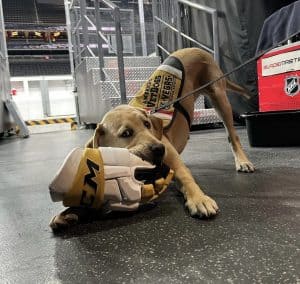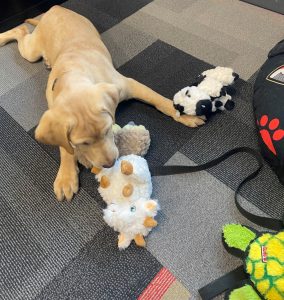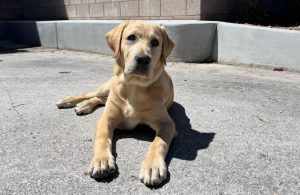
Dogs with Jobs: Maverick the Hockey Pup
Read about how Maverick, a labrador retriever puppy, is training with the Vegas Golden Knights hockey team to become a service dog for veterans with PTSD.
It’s 8:30am and Maverick is making his rounds through the office cubicles, collecting morning treats and love at the Vegas Golden Knights hockey team’s headquarters. Once he’s made his rounds at the office, Maverick heads down to the locker room for the most exciting part of his workday—to greet the Golden Knights hockey players for rounds of team bonding, snuggles and belly rubs, and playtime with his favorite KONG® toys. 
Playing for a Greater Cause
Maverick has become a daily staple and family member for the entire team and staff of the Golden Knights. But time spent with the team isn’t just for fun. It’s real-life training for a greater cause: Becoming a therapy dog for a service veteran with post-traumatic stress disorder (PTSD) with America’s VetDogs.
Maverick, a 4-month-old labrador retriever, will be in training for 17 months with his puppy raisers, Kim Frank, Mia Greenlee, and Allie Emery of the Vegas Golden Knights’ Foundation and Community Relations team, to become a service dog. Throughout this time, he will learn basic obedience commands, positive socialization, exposure to different environments and public settings, and how to remain calm in each scenario without barking or jumping. Maverick goes everywhere with his trainers—Starbucks, the grocery store, restaurants, movies, the Vegas Strip (where he’s become a local legend), and even home hockey games—all while donning his training vest and teaching people about his mission!
One of Maverick’s favorite KONG toys that keeps him focused while he’s at the games and other busy locations is a frozen Goodie Bone stuffed with peanut butter and pumpkin puree.
Before Maverick, VGK team owner Bill Foley was involved in helping and supporting veterans. As a 1967 graduate of West Point Military School, Mr. Foley was familiar with the daily needs of veterans. After two years of consideration, Bill and the team finally decided to partner with America’s VetDogs to take on a service puppy of their own, with the mission for their puppy to not only support the team, but go on to help a veteran as a service dog.
Maverick’s Mission
Once Maverick completes his puppy training, he will move forward with his formal service dog career training. When this training is complete, Maverick will graduate and be matched with and adopted by a veteran.
You can become a Puppy Raiser, volunteer, and give to America’s VetDogs in many ways! Visit www.vetdogs.org to learn about their mission, veteran service dogs, and more.
Follow Maverick’s journey on Instagram @VGKpup or @VegasGoldenKnights. Follow America’s VetDogs on Instagram @americasvetdogs
 from Laurel Lewis
from Laurel Lewis




